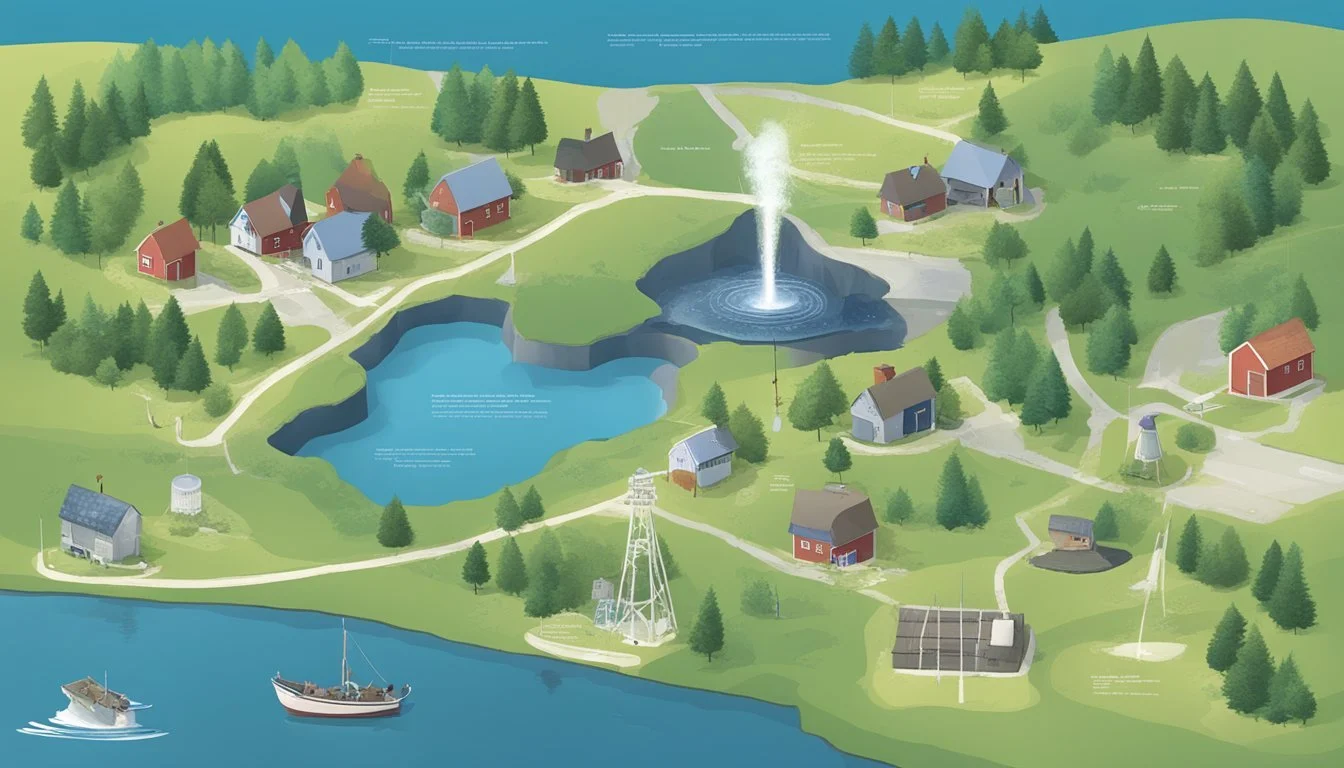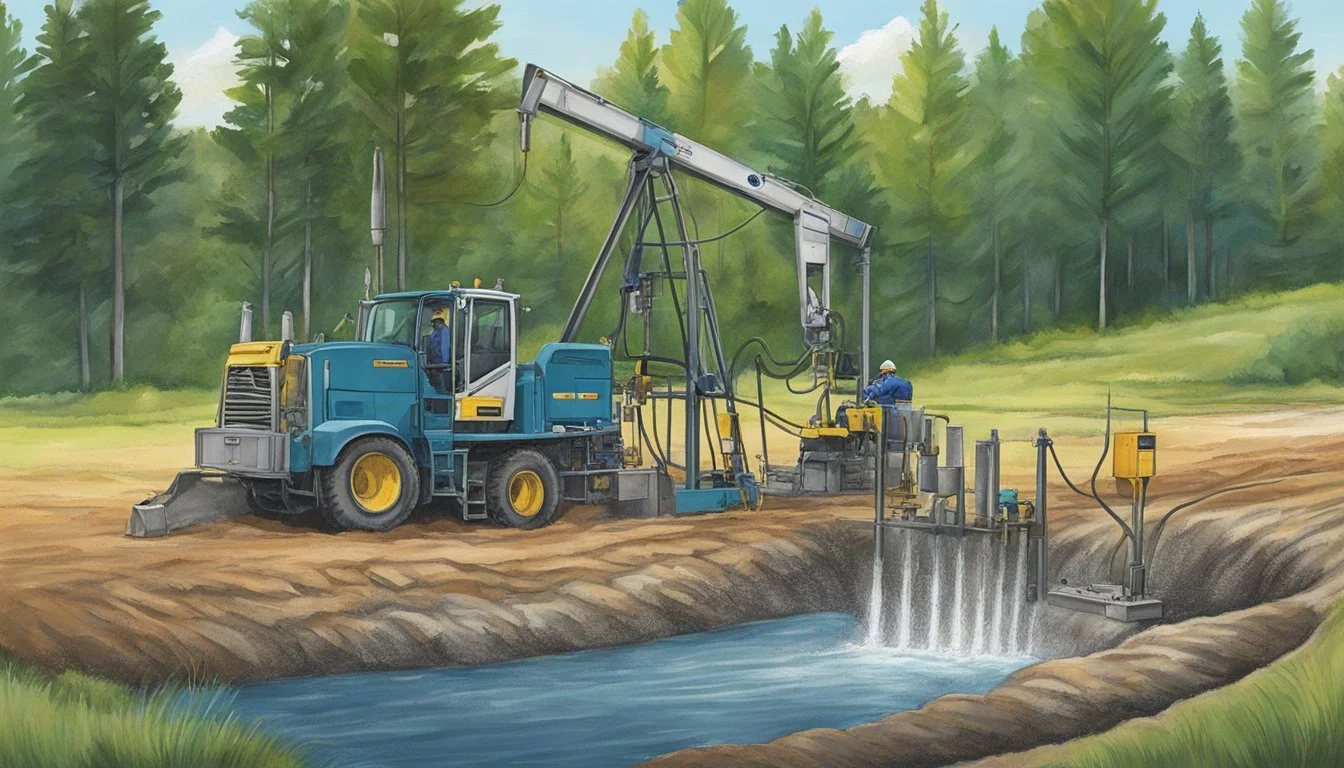Vermont Water Well Regulations
Understanding the Essentials for Compliance
Vermont places a high priority on the protection and management of its groundwater resources, which serve as a crucial source of drinking water for its residents. State regulations are meticulously designed to ensure that the water withdrawn from various sources, including wells, meets stringent health and safety standards. These regulations govern the construction, operation, and maintenance of both public and private water systems, with the aim of preserving the integrity of Vermont's groundwater and the health of its communities.
The Vermont Water Supply Rule, which was most recently updated on March 17, 2020, establishes comprehensive standards for water systems ranging from small, individual wells to the largest suppliers in the state. The rule forms part of a framework that enables Vermont to maintain 'primacy' over the enforcement of the Safe Drinking Water Act, effectively allowing the state to oversee the implementation of federal regulations domestically. Consequently, anyone involved in well drilling or water system management in Vermont must comply with these regulations to ensure that all citizens have access to clean and safe drinking water.
Regulatory Framework
In Vermont, water quality and safety are governed by a comprehensive set of regulations that provide a framework for the protection of public health and the environment. These regulations ensure that public water systems are in compliance with both state and federal requirements, spanning from well construction to the reporting of water quality data.
Vermont State Statutes
Vermont's Agency of Natural Resources (ANR) is charged with the enforcement of environmental laws as enacted by the state's legislature. Within the ANR, the Department of Environmental Conservation (DEC) is responsible for implementing policies that pertain to water quality. The Vermont state statutes form the backbone of the state's environmental regulations, empowering the DEC to oversee all aspects related to water supply systems.
Environmental Protection Rules
The Environmental Protection Rules, including the federal rules delineated in Title 40 Volume 22 Chapter 1 Parts 141, 142, & 143, lay the ground rules for the protection and regulation of drinking water. These federal drinking water regulations have been adopted by Vermont, which translate into enforceable standards for the monitoring and maintenance of water quality.
Ground Water Protection Act
Vermont's Ground Water Protection Act serves to safeguard the state's groundwater resources from contamination. This includes setting forth standards for well construction to prevent surface pollutants from affecting groundwater supplies, which are crucial for the majority of Vermont's public water systems.
Public Water Systems Regulations
The Water Supply Rule is essential for regulating public water systems in Vermont, especially those serving more than 25 people. This rule encompasses a range of regulations from system design to contamination response and is vital for ensuring the delivery of safe and clean drinking water. The state's compliance with the Safe Drinking Water Act is affirmed through adherence to these comprehensive rules, as maintained by the DEC under the policy guidelines set by the Vermont governor and legislature.
Water Well Standards and Practices
Vermont has robust regulations to ensure that water wells are constructed and maintained to high standards, protecting groundwater resources and ensuring safe drinking water. These include detailed construction standards and licensing requirements for well drillers, and practices defined in several key rules.
Well Construction Standards
Well construction in Vermont must adhere to the specific requirements set forth to safeguard groundwater quality. All wells must maintain certain isolation distances from potential contaminants. Additionally, the materials used and the construction process must be aligned with the recommended guidelines to prevent the ingress of pollutants. The casing, which forms the well shaft, must be durable and installed correctly to protect against surface contaminants.
Well Driller Licensing Rule
To ensure professional and legal drilling practices, Vermont mandates that all well drillers obtain a license. This requirement ensures they are familiar with the regulations and skilled in contemporary well construction techniques. Licensing also includes the obligation to submit a well completion report, which records the specifics of the well construction and assists in the proper management of groundwater resources.
Potable Water Supply Rule
Vermont's Potable Water Supply Rules provide definitions and controls over potable water systems. These rules include well construction standards to ensure that potable water is safe from contaminants. Important features of the rules involve procedures for testing new drilled wells, covering an array of contaminants to certify the water is safe for consumption.
Groundwater Protection Rule and Strategy
The Groundwater Protection Rule encompasses strategies to protect groundwater from depletion and contamination. Licensed well drillers must observe practices that limit the withdrawal of groundwater to sustainable levels, report any groundwater withdrawal, and follow remediation procedures if contamination is detected. The rule operates in conjunction with other environmental regulations to preserve the quality and availability of Vermont's precious groundwater resources.
Water Supply Management
In Vermont, the emphasis on water supply management is central to ensuring public health and environmental integrity. The regulations are stringent, designed to ensure that all aspects of water use—from the moment water is extracted to the point where it is disposed of—are carefully controlled.
Design and Construction
Proper design and construction of water wells are critical to prevent contamination of potable water supplies. In Vermont, professional engineers and certified designers are required to follow rigorous construction standards for both public water systems and private wells. The goal is to protect surface water and the underlying aquifers from potential pollutants, maintaining a safe drinking water supply.
Monitoring and Operation
Monitoring and effective operation of water systems involve regular testing of water quality, ensuring consistent flow and maintaining adequate storage. In Vermont, water system operators are responsible for ongoing oversight of community and non-community water systems, including the management of wastewater systems to prevent contamination of drinking water resources.
Wastewater System and Potable Water Supply
The wastewater system and potable water supply are interrelated, as the proper handling of waste is imperative to protect drinking water. Vermont's regulations guide how wastewater is managed, focusing on reducing impacts to both groundwater and surface water bodies. Systems must be designed to minimize leakage and failure, ensuring that public health is not compromised.
Public Health and Safety
Ensuring public health and safety is the cornerstone of Vermont's water supply management. Strict adherence to the Potable Water Supply Rule and Underground Injection Control regulations protects the public from waterborne diseases and exposure to hazardous substances. Applications for new water supply systems undergo thorough review to confirm that they meet health and safety standards, prioritizing community well-being.
Environmental and Health Impacts
Vermont's water well regulations are crucial for maintaining the quality and safety of the state's water resources. They address issues like groundwater contamination and assure the protection of public water supplies by setting standards for drinking water safety and promoting the conservation of natural resources.
Groundwater Contamination
Groundwater is a vital resource for Vermont, supplying drinking water to many residents via springs and wells. Groundwater contamination can occur due to a variety of factors, such as septic waste disposal, indirect discharge from industrial processes, and runoff from agricultural lands. Contaminants from these sources, including petroleum products, pesticides, and naturally occurring chemicals like arsenic or manganese, pose significant risks to public health and the environment. Regular testing and remediation are essential steps to prevent and address such contamination.
Public Water Supply Protection
Public water systems in Vermont are subject to stringent regulations that ensure safe drinking water for all users. These regulations encompass a wide scope, from setting permissible levels of contaminants and gross alpha radiation to enforcing standards on the acceptable depth of water wells to prevent surface contaminants from entering the groundwater supply. Efforts to protect Lake Champlain and other service waters also contribute to maintaining the integrity of the public water supply.
Drinking Water Safety
Drinking water safety is a prominent concern, especially in relation to private wells and springs which may be susceptible to various contaminants including bacteria, viruses, lead in consumer products, and other substances. Vermont mandates regular testing for these contaminants and implements public water system regulations that govern groundwater withdrawal to reduce the likelihood of contaminated water reaching consumers. Adherence to these regulations ensures that Vermont's safe drinking water standards are met.
Natural Resource Conservation
Conserving natural resources, including ice, lakes, and groundwater, is essential to protect the environment and public health in Vermont. The implementation of public water supply protection measures such as testing for contaminants and regulating the depth at which groundwater can be withdrawn helps preserve the state's water quality. Additionally, strategies for the disposal of waste materials and remediation of contaminated sites aid in protecting these vital resources from irreversible damage.
Administrative Aspects
In Vermont, the management of water wells involves a structured administrative approach that ensures proper licensing, reporting, and compliance. These measures are pivotal in maintaining the safety and quality of groundwater resources.
Licensing and Certification
The Agency of Natural Resources, specifically the Groundwater Protection Division, mandates that all well drillers obtain appropriate licensing. This process, overseen by the Office of Professional Regulation, includes submitting relevant forms and undergoing necessary education to meet state standards. Drillers must also provide well completion reports, fostering transparency and allowing for effective monitoring of groundwater resources.
Reporting and Data Management
Well drillers are required to submit these well completion reports to the state, ensuring accurate data management. The submission process is made efficient through FTP data upload instructions, which guides the transfer of information into the state's comprehensive database. This facilitates the Agency of Natural Resources in evaluating groundwater withdrawal patterns and ensures policy adherence.
Compliance and Enforcement
The state upholds compliance through systematic enforcement of its regulations, under the authority of the Secretary of the Agency of Natural Resources. The Groundwater Protection Division, alongside the Advisory Committee, reviews permits and enforces rules concerning indirect discharge. They provide assistance to drillers and the public to nurture a culture of compliance. Persistent non-compliance can result in penalties to safeguard Vermont’s water resources.
Frequently Asked Questions
The questions below address key elements concerning regulations for water wells in Vermont, providing clear information on permitting, location rules, water quality standards, and safety guidelines.
What are the permitting requirements for drilling a well in Vermont?
In Vermont, individuals planning to drill a well must ensure that all necessary permits are acquired before commencement. The well driller should verify with the landowner whether applicable permits are required and if they have been obtained.
How close can a well be situated to a septic system under Vermont regulations?
The state of Vermont specifies isolation distances for the location of water wells to prevent contamination. All wells must adhere to mandatory separation distances from septic systems to maintain water integrity.
What do the Vermont Water Supply Rule Chapter 21 statutes entail?
The Vermont Water Supply Rule Chapter 21 outlines the construction and isolation standards for wells, which includes criteria for site selection, drilling, and protecting water quality.
What standards govern groundwater quality in Vermont?
Groundwater quality in Vermont is regulated under robust standards aimed at preserving public health. These regulations ensure that any new drilled well testing meets the requirements for contaminants and provides safe drinking water.
Are there any recent updates to Vermont water well regulations since 2020?
Vermont keeps its water well regulations current with evolving environmental and public health concerns. For the most recent changes to the regulations, one can review the Responsiveness Summary to 2023 proposed Water Supply Rule Changes which reflects updates since 2020.
What guidelines must be followed to ensure tap water safety in Vermont?
To ensure tap water safety, Vermont has established guidelines that include mandatory water testing and treatment protocols. These guidelines are detailed for both public and private water systems to maintain high drinking water quality standards.






